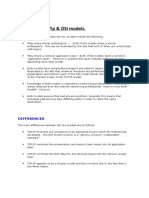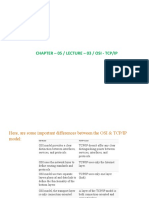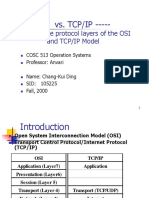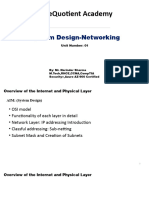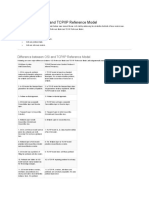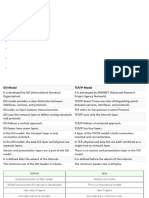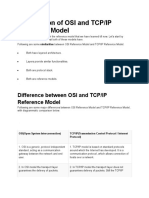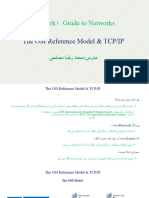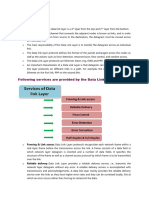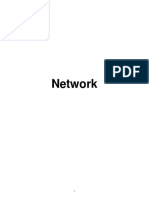0 ratings0% found this document useful (0 votes)
7 viewsCN SLT1
CN SLT1
Uploaded by
b22in025The document summarizes a lecture on comparing the OSI and TCP/IP reference models. It discusses key differences between the two models, including that TCP/IP has 4 layers while OSI has 7 layers, TCP/IP is more reliable while OSI is less reliable, and TCP/IP follows a horizontal approach while OSI follows a vertical approach. It also provides example differences in individual layers between the models. The document concludes by listing two practice problems to test if learners achieved the learning outcomes of comparing how TCP/IP differs from OSI.
Copyright:
© All Rights Reserved
Available Formats
Download as PDF, TXT or read online from Scribd
CN SLT1
CN SLT1
Uploaded by
b22in0250 ratings0% found this document useful (0 votes)
7 views2 pagesThe document summarizes a lecture on comparing the OSI and TCP/IP reference models. It discusses key differences between the two models, including that TCP/IP has 4 layers while OSI has 7 layers, TCP/IP is more reliable while OSI is less reliable, and TCP/IP follows a horizontal approach while OSI follows a vertical approach. It also provides example differences in individual layers between the models. The document concludes by listing two practice problems to test if learners achieved the learning outcomes of comparing how TCP/IP differs from OSI.
Original Title
CN_SLT1
Copyright
© © All Rights Reserved
Available Formats
PDF, TXT or read online from Scribd
Share this document
Did you find this document useful?
Is this content inappropriate?
The document summarizes a lecture on comparing the OSI and TCP/IP reference models. It discusses key differences between the two models, including that TCP/IP has 4 layers while OSI has 7 layers, TCP/IP is more reliable while OSI is less reliable, and TCP/IP follows a horizontal approach while OSI follows a vertical approach. It also provides example differences in individual layers between the models. The document concludes by listing two practice problems to test if learners achieved the learning outcomes of comparing how TCP/IP differs from OSI.
Copyright:
© All Rights Reserved
Available Formats
Download as PDF, TXT or read online from Scribd
Download as pdf or txt
0 ratings0% found this document useful (0 votes)
7 views2 pagesCN SLT1
CN SLT1
Uploaded by
b22in025The document summarizes a lecture on comparing the OSI and TCP/IP reference models. It discusses key differences between the two models, including that TCP/IP has 4 layers while OSI has 7 layers, TCP/IP is more reliable while OSI is less reliable, and TCP/IP follows a horizontal approach while OSI follows a vertical approach. It also provides example differences in individual layers between the models. The document concludes by listing two practice problems to test if learners achieved the learning outcomes of comparing how TCP/IP differs from OSI.
Copyright:
© All Rights Reserved
Available Formats
Download as PDF, TXT or read online from Scribd
Download as pdf or txt
You are on page 1of 2
Department of CSE(IoT), U18IN306
U18 COMPUTER NETWORKS
KITSW
3CSO1 AY:2023-24
SLT1 - LECTURE SUMMARY
SLT1 Topics Comparison of OSI and TCP/IP reference model
Covered
Both OSI and TCP/IP reference models provide a framework for creating and
Motivation
implementing networking standards and devices devices.. Both divide the network
(Why you communication process into layers. In both models, a single layer defines a
(students) should particular functionality and sets standards for that functionality only.
learn these topics? )
Lecture Learning Outcomes (LLOs): After completion of this lecture, you should be able to…
LLO1
On topic
Compare how TCP/IP is different from OSI
1
SLT1 – Lecture Summary – Key Takeaways
Difference between TCP/IP and OSI Model:
TCP/IP OSI
TCP refers to Transmission
Control Protocol. OSI refers to Open Systems Interconnection.
TCP/IP has 4 layers. OSI has 7 layers.
Department of CSE(IoT), U18IN306 COMPUTER NETWORKS
KITSW
3CSO1 AY:2023-24
SLT1 - LECTURE SUMMARY
TCP/IP is more reliable OSI is less reliable
TCP/IP does not have very strict
boundaries. OSI has strict boundaries
TCP/IP follow a horizontal
approach. OSI follows a vertical approach.
TCP/IP uses both session and
presentation layer in the OSI uses different session and presentation
application layer itself. layers.
TCP/IP developed protocols then
model. OSI developed model then protocol.
Transport layer in TCP/IP does not
provide assurance delivery of In OSI model, transport layer provides
packets. assurance delivery of packets.
Connection less and connection oriented
TCP/IP model network layer only both services are provided by network layer
provides connection less services. in OSI model.
While in OSI model, Protocols are better
Protocols cannot be replaced covered and is easy to replace with the
easily in TCP/IP model. change in technology.
SLT1- LECTURE LEVEL PRACTICE PROBLEMS (LLPs) to test the LLOs
To test whether you achieved the learning outcomes of this lecture, you should be able to solve the following
LLPs, in the class itself, after completion of the lecture. Minimum one question / problem (LLP) is designed to
test each expected LLO.
1. LLP1(on LLO1):
Q. What is PORT?
A port is basically a physical docking point that is basically used to connect the external devices to the computer, or we
can say that a port acts as an interface between the computer and the external devices, e.g., we can connect hard drives
and printers to the computer with the help of ports
2.Q. Define Protocol?
A protocol is a set of rules and guidelines for communicating data. Rules are defined for each step and process during
communication between two or more computers.
U18IN306 CN 3CSO1 Dr.V.Shankar Dept of CSN, KITSW Page 2 of 2
You might also like
- Wistron Watchmen - Cyborg AMD 203000, 203076Document106 pagesWistron Watchmen - Cyborg AMD 203000, 203076Sahid Cota Camacho100% (1)
- Ch02 Network ModelsDocument36 pagesCh02 Network ModelsBilal MughalNo ratings yet
- Differences Between OSI and TCDocument2 pagesDifferences Between OSI and TCNaveen KumarNo ratings yet
- TCP/IP Model Vs OSI Model: Computer NetworkingDocument5 pagesTCP/IP Model Vs OSI Model: Computer NetworkingRaj KumarNo ratings yet
- Data Communication & NetworksDocument8 pagesData Communication & Networksrukhsar siddiqueNo ratings yet
- S3 & S4 - Osi TcpipDocument21 pagesS3 & S4 - Osi Tcpipsripallavid1214No ratings yet
- Puter Networks (TCP IP MODEL)Document9 pagesPuter Networks (TCP IP MODEL)Watch WebseriesNo ratings yet
- Transport LayerDocument7 pagesTransport LayerMehboob NazimNo ratings yet
- Comparison Between IOS & TCPDocument8 pagesComparison Between IOS & TCPMayada GamalNo ratings yet
- Lecture 2Document14 pagesLecture 2clely fernandesNo ratings yet
- Overview of TCP/IP Reference ModelDocument4 pagesOverview of TCP/IP Reference ModelPRODIP DEBNo ratings yet
- Network Communication ModelsDocument7 pagesNetwork Communication ModelsFilipe NahorNo ratings yet
- Comparing Tcp-IP & OSIDocument2 pagesComparing Tcp-IP & OSIDan Kimbo Slice MartellNo ratings yet
- Wepik The Comprehensive Analysis of Osi and Tcpip Models Unveiling The Purpose Structure and Functiona 20240128161622zfu9Document7 pagesWepik The Comprehensive Analysis of Osi and Tcpip Models Unveiling The Purpose Structure and Functiona 20240128161622zfu9Souvik PalNo ratings yet
- Chapter - 05 / Lecture - 03 / Osi - Tcp/IpDocument10 pagesChapter - 05 / Lecture - 03 / Osi - Tcp/IpNagaraj VaratharajNo ratings yet
- TCP - IP Model ShubroDocument21 pagesTCP - IP Model ShubroShubrojyoti ChowdhuryNo ratings yet
- Which Model Is Better, OSI or TCP - IPDocument5 pagesWhich Model Is Better, OSI or TCP - IPFAYSAL AhamadNo ratings yet
- Arya CNDocument10 pagesArya CNriju2bs8No ratings yet
- OSI and TCP/IP Models EssayDocument4 pagesOSI and TCP/IP Models EssayannikaNo ratings yet
- IPU MCA Advance Computer Network Lecture Wise Notes (Lec03 (TCPIP) )Document3 pagesIPU MCA Advance Computer Network Lecture Wise Notes (Lec03 (TCPIP) )Vaibhav JainNo ratings yet
- Four Layers of TCP/IP Model Explained: Difference Between TCP/IP and OSI ModelDocument3 pagesFour Layers of TCP/IP Model Explained: Difference Between TCP/IP and OSI Modelsundar anandanNo ratings yet
- Network Layer StackDocument13 pagesNetwork Layer Stackleslie010No ratings yet
- 2.7 Osi and TCP ModelDocument13 pages2.7 Osi and TCP ModelM M Naib KhanNo ratings yet
- OSI Vs TCP - IPDocument3 pagesOSI Vs TCP - IPgullapalli123No ratings yet
- CDT2 SummaryDocument7 pagesCDT2 SummaryKAMAKSHI PILLENo ratings yet
- Osi and TCPDocument2 pagesOsi and TCPDnyan navgareNo ratings yet
- SD NetworksDocument60 pagesSD NetworkslakshayNo ratings yet
- Danish PDFDocument12 pagesDanish PDFDanish AlamNo ratings yet
- Difference Between OSI and TCP/IP Reference ModelDocument2 pagesDifference Between OSI and TCP/IP Reference ModelReign Earl B. Gup-ayNo ratings yet
- PO BT1005 C01 0TCPIPBasisDocument41 pagesPO BT1005 C01 0TCPIPBasisAngelica Maria Gonzalez OrtegaNo ratings yet
- unit3.6Document9 pagesunit3.6say.talekarNo ratings yet
- Network Layers: The OSI and Internet ModelsDocument33 pagesNetwork Layers: The OSI and Internet ModelsebinVettuchirayilNo ratings yet
- 10comparison of OSI and IP Reference ModelDocument3 pages10comparison of OSI and IP Reference ModelJawad SandhuNo ratings yet
- Osi Model and TCP AssignmentDocument7 pagesOsi Model and TCP AssignmentFrancis PulaiziNo ratings yet
- Difference Between OSI and TCPIP ModelsDocument2 pagesDifference Between OSI and TCPIP ModelsSami khan orakzai83% (6)
- FIT3143 Topic 2 2024Document51 pagesFIT3143 Topic 2 2024ella.davis.9811No ratings yet
- TCP Vs OsiDocument5 pagesTCP Vs OsiAtinderpal SinghNo ratings yet
- Computer NetworksDocument24 pagesComputer NetworksJeena Mol AbrahamNo ratings yet
- Electronic Circuit Style CV by SlidesgoDocument38 pagesElectronic Circuit Style CV by SlidesgoJC CanlasNo ratings yet
- Osimodel 170406162300 PDFDocument42 pagesOsimodel 170406162300 PDFPvkkiy EceNo ratings yet
- 5.3 TCP IP Protocol ArchitectureDocument22 pages5.3 TCP IP Protocol Architecturehazardahmed132No ratings yet
- OSI and TCP IP Model Layers OSI and TCP IP Model Layers PearsonDocument4 pagesOSI and TCP IP Model Layers OSI and TCP IP Model Layers PearsonTefeNo ratings yet
- L No.5-6 Compare TCP Model Vs Osi ModelDocument16 pagesL No.5-6 Compare TCP Model Vs Osi Modelakshitsharmaji108No ratings yet
- Concepts Are Central To The OSI ModelDocument2 pagesConcepts Are Central To The OSI ModelPrem RajNo ratings yet
- CN Unit2Document6 pagesCN Unit2OmNo ratings yet
- The OSI and TCPDocument8 pagesThe OSI and TCPSreejith VaneryNo ratings yet
- TCP IpDocument13 pagesTCP Ipingawalemadhura5722No ratings yet
- Open System Interconnection Protocols: Chapter GoalsDocument10 pagesOpen System Interconnection Protocols: Chapter Goalsf00k3r100% (1)
- Osi TCP IpDocument4 pagesOsi TCP Ipkd ahmedNo ratings yet
- Difference Between OSI and TCP/IP Reference ModelDocument8 pagesDifference Between OSI and TCP/IP Reference Modelremya mohanNo ratings yet
- OSI & TCP - Ip1 PDFDocument3 pagesOSI & TCP - Ip1 PDFSavita BhabhiNo ratings yet
- Computer Network Report - CA2 - Tirtharaj Pati - 14201619089 PDFDocument4 pagesComputer Network Report - CA2 - Tirtharaj Pati - 14201619089 PDFTirtharaj PatiNo ratings yet
- Configuring TCP/IP Under LinuxDocument23 pagesConfiguring TCP/IP Under Linuxrich7enkoNo ratings yet
- Comparative Analysis of OSI and TCP/IP Models in Network Communication.Document7 pagesComparative Analysis of OSI and TCP/IP Models in Network Communication.Kelvin NnamaniNo ratings yet
- Chapter-4 SNDocument68 pagesChapter-4 SNbeshahashenafi32No ratings yet
- Lesson 02-03 - OSI ModelDocument73 pagesLesson 02-03 - OSI Modelnami22039No ratings yet
- Introduction To Network+ Lesson2Document17 pagesIntroduction To Network+ Lesson2mr moslehi85No ratings yet
- TCP/IP: Network+ Protocols And Campus LAN Switching FundamentalsFrom EverandTCP/IP: Network+ Protocols And Campus LAN Switching FundamentalsNo ratings yet
- Cisco Certified Network Associate (CCNA) and Cisco Certified Network Professional (CCNP): Mastering Network Automation and Programmability Study GuideFrom EverandCisco Certified Network Associate (CCNA) and Cisco Certified Network Professional (CCNP): Mastering Network Automation and Programmability Study GuideNo ratings yet
- All India Price ListDocument7 pagesAll India Price Listyacivo7960No ratings yet
- Unit 3Document31 pagesUnit 3sahilNo ratings yet
- Module 15Document45 pagesModule 15Camille BleossiNo ratings yet
- 5 - Network Layer Control PlaneDocument13 pages5 - Network Layer Control Planeep21b004No ratings yet
- Onyx Ethernet Release Notes For HPE PDFDocument66 pagesOnyx Ethernet Release Notes For HPE PDFmarlonpatoNo ratings yet
- OSI Model Layers and Protocols in Computer NetworkDocument102 pagesOSI Model Layers and Protocols in Computer NetworkNazar N. AkashaNo ratings yet
- Question CCNA 200-3001Document11 pagesQuestion CCNA 200-3001juan hernandezNo ratings yet
- 1 Data Sheet Nokia 7750 Service RouterDocument13 pages1 Data Sheet Nokia 7750 Service RouterCamilo OrozcoNo ratings yet
- ManualDocument84 pagesManualLuis Henrique CarraraNo ratings yet
- MA5800T Product Description 02-2Document7 pagesMA5800T Product Description 02-2chiu jefucNo ratings yet
- How To Configure IPSec Site-to-Site VPN Tunnel On OPNsenseDocument38 pagesHow To Configure IPSec Site-to-Site VPN Tunnel On OPNsenseWelkson Renny de Medeiros100% (1)
- ACN Chapter 2 - Part 1 Notes by Ur Engineering FriendDocument5 pagesACN Chapter 2 - Part 1 Notes by Ur Engineering Friend9B - 38Karan BhanushaliNo ratings yet
- Chapter5 NetworkLayer, Part1Document73 pagesChapter5 NetworkLayer, Part1Dwayne HerryNo ratings yet
- Remote Desktop ServiceDocument13 pagesRemote Desktop ServiceZain GondalNo ratings yet
- Download full Computer Networking A Top-Down Approach 6th Edition Kurose Solutions Manual all chaptersDocument31 pagesDownload full Computer Networking A Top-Down Approach 6th Edition Kurose Solutions Manual all chaptersdewranboikob100% (7)
- ZXR10 5950-H DatasheetDocument11 pagesZXR10 5950-H DatasheetAlexander PischulinNo ratings yet
- HSV HC35W4xR2 01 US (0622) DS Y FINALDocument3 pagesHSV HC35W4xR2 01 US (0622) DS Y FINALHéctor RodríguezNo ratings yet
- B Routing CG Ncs5500 71xDocument300 pagesB Routing CG Ncs5500 71xpaulNo ratings yet
- ETSI TS 138 323: 5G NR Packet Data Convergence Protocol (PDCP) Specification (3GPP TS 38.323 Version 17.4.0 Release 17)Document52 pagesETSI TS 138 323: 5G NR Packet Data Convergence Protocol (PDCP) Specification (3GPP TS 38.323 Version 17.4.0 Release 17)rkaul2763No ratings yet
- Formal Security Analysis of Vehicle Diagnostic Protocols: Timm Lauser Christoph KraußDocument11 pagesFormal Security Analysis of Vehicle Diagnostic Protocols: Timm Lauser Christoph Krauß2022mt12374No ratings yet
- SET B FinalDocument8 pagesSET B Finaladhe laishramNo ratings yet
- 2012 Final SolutionDocument10 pages2012 Final Solutionrameenbutt990No ratings yet
- Attachment Programme - Lovemore KambamuraDocument9 pagesAttachment Programme - Lovemore KambamuraLovemore KambamuraNo ratings yet
- ACN-Unit 1Document57 pagesACN-Unit 1Dhanesh Uday PujareNo ratings yet
- Network CommandsDocument167 pagesNetwork CommandsSalyo DrajatNo ratings yet
- GS10 SMS Command Wanwaytech 6.21 Manual 1Document2 pagesGS10 SMS Command Wanwaytech 6.21 Manual 1javihov546No ratings yet
- ST-One Communication ServicesDocument3 pagesST-One Communication ServicesRogerio ErnestoNo ratings yet
- Huawei CloudEngine S5735-L-V2 Series Switches DatasheetDocument32 pagesHuawei CloudEngine S5735-L-V2 Series Switches DatasheetPaulo DinizNo ratings yet
- Extreme 9251083Document136 pagesExtreme 9251083Juan Carlos Serna PinedaNo ratings yet












